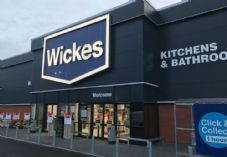UK DIY News
Wickes: The Evolution Of The Kitchen Triangle

- The kitchen triangle design is set to change for first time in over 50 years – so what shape are you?
Wickes and its team of experienced kitchen Design Consultants help shoppers discover their ‘perfect shape’ with the help of tailor-made 360° designs
A new study by home improvement business Wickes has revealed that the classic 1960s kitchen ‘work triangle’ of cooker-sink-fridge, at the heart of UK kitchen design for over half a century, is set to change due to the demands of modern-day Brits.
The kitchen is now the heart of the home, so it’s important that the style and layout works for families in a multifunctional capacity. Whether you are looking for a room that fills you with creativity or one that fuels you with motivation and focus, your kitchen should be set up in such a way that fits with your lifestyle. And the way that happens is more than just paint and decor – although that helps – it really comes down to the design layout being the perfect shape for you.
Originally developed in 1929 by US time and motion studies expert Lilian Moller Gilbreth, the kitchen triangle concept suggests that the three main ‘work points’ of the kitchen should form an imaginary triangular shape to maximise efficiency and cut down on wasted steps.
But contemporary kitchen layouts are now increasingly incorporating a combination of points that stretch far beyond those established over half a century ago. Experts claim that the changing use of the kitchen means that the latest design shape requirements can be anything from a triangle to a hexagon and rising to a heptagon for some householders. The main touchpoints include a tea, coffee and drinks preparation point and ‘feet on the floor’ eating area, as well as a multi-functional space for things such as crafting and homeschooling.
What shape are you?
- Triangle - points: 1) food storage, 2) sink/dishwasher, 3) oven/hob
- Kite - points: 1) food storage, 2) sink/dishwasher, 3) oven/hob, 4) drinks zone
- Pentagon - points: 1) food storage, 2) sink/dishwasher, 3) oven/hob, 4) drinks zone, 5) ‘feet on the floor’ eating zone
- Hexagon - points: 1) food storage, 2) sink/dishwasher, 3) oven/hob, 4) drinks zone, 5) ‘feet on the floor’ eating zone, 6) multi-functional space
- Heptagon - points: 1) food storage, 2) sink/dishwasher, 3) oven/hob, 4) drinks zone, 5) ‘feet on the floor’ eating zone, 6) multi-functional space, 7) pet zone
.jpg)
To further explore these findings, Wickes partnered with Professor Deborah Sugg Ryan, Design Historian at the University of Portsmouth. Deborah says: ‘The classic kitchen work triangle has been at the heart of UK kitchens since the 1960s, but that has changed as kitchens have become more flexible, fluid and social spaces.
‘We’re moving away from the nuclear family with multi-generational households, as Generation Rent means children are living longer at home with parents. In addition, social factors like varied eating habits means people now come and go in the kitchen to do their own thing, whereas once it was expected that the solo housewife was central to everything that happened there.
‘Working from home is also here to stay, which means millions of us seeking a space in the kitchen on a daily basis if not to permanently work, to drop in with our laptops or tablets.
‘Everything points to the modern kitchen needing more flexible surfaces for what we want to do - and that means the kitchen work triangle will be updated with more design points.’
The Wickes study also reveals that in 2021, Brits prioritise points such as a tea, coffee and drinks preparation area, named by 29% of Brits as an essential element, a seated ‘feet on the floor’ dining area (23%) which potentially signals the demise of the dining room, and space for home or school working (13% and 12%). Also, the increase in domestic pet ownership during the pandemic means one in five Brits now believe the kitchen needs a dedicated pet area.
The most requested points within any Kitchen Shape were identified as:
1) Food storage (fridge/freezer/pantry)
2) Oven/hob/cooking appliance
3) Sink/dishwasher
4) Drinks point (tea, coffee and/or bar)
5) ‘Feet on the floor’ eating zone
6) Multi-functional space (work from home point/home schooling/baking/crafting)
For those with a dog, cat or similar family addition, a pet zone is listed as the seventh point.
Whereas the original triangle shape was designed around a housewife moving about the three points of cooker, sink and fridge, there are now typically two people in the average British kitchen at peak times (43%). That’s because two people will be typically involved in the cooking and food prep rather than one, and in 10% of homes the kitchen is packed with FOUR more people at peak time. The average Brit also now spends 1 hr 49 mins each day in the kitchen.
Michaela Williams, Design Consultant, Wickes, says: ‘Lilian Moller Gilbreth’s kitchen work triangle was a design classic of the 20th century - and in the 21st century, we need to build on it and provide more work points in the same space.
‘While the distance between cooker, sink and fridge is still important in modern kitchen design, we’re increasingly seeing when speaking to our customers, that people now want room for appliances such as a coffee machine, which may or may not be on display and flexible worktop space so they can plug a laptop in for working from home or home-schooling but equally bake or craft and clear everything away.
‘From bespoke built in pet beds to an area to make guests their tea or coffee, today’s kitchen design requests are more varied than ever. It’s our team’s job to enquire which shape our customers need, and ensure these complex layouts are designed intelligently so they can make the most of their space.’
Whatever shape shoppers opt for, Wickes and its team of experienced Design Consultants can help to bring the nation’s kitchen dreams to life with cutting edge virtual reality programmes.
Information on how the service works can be found here on the brand’s virtual design page, this includes a video with their Design Consultants describing the process, together with showing customers where to go to book their free design appointment.
Source : Wickes
Insight DIY is the only source of market information that I need and they always have the latest news before anyone else.











































